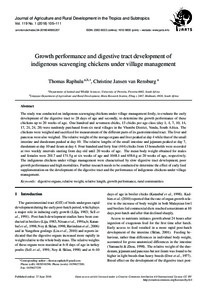Aufsatz

Growth performance and digestive tract development of indigenous scavenging chickens under village management
Zusammenfassung
The study was conducted on indigenous scavenging chickens under village management firstly, to evaluate the early development of the digestive tract to 28 days of age and secondly, to determine the growth performance of these chickens up to 20 weeks of age. One hundred and seventeen chicks, 13 chicks per age class (day 1, 4, 7, 10, 14, 17, 21, 24, 28) were randomly purchased from six rural villages in the Vhembe District, Venda, South Africa. The chickens were weighed and sacrificed for measurement of the different parts of its gastrointestinal tract. The liver and pancreas were also weighed. The relative weight of the storage organs and liver peaked at day 4 while that of the small intestine and duodenum peaked at day 10. The relative lengths of the small intestine and jejunum peaked at day 7, duodenum at day 10 and ileum at day 4. Four hundred and forty four (444) chicks from 13 households were recorded at two weekly intervals starting from day old until 20 weeks of age. The mean body weight obtained for males and females were 201.7 and 171.5 g at six weeks of age and 1048.1 and 658.6 g at 20 weeks of age, respectively. The indigenous chickens under village management were characterised by slow digestive tract development, poor growth performance and high mortalities. Further research needs to be conducted to determine the effect of early feed supplementation on the development of the digestive tract and the performance of indigenous chickens under village management.
Zitierform
In: Journal of Agriculture and Rural Development in the Tropics and Subtropics. Kassel : Kassel University Press. - Vol. 119, No. 1 (2018) S. 105-111Sammlung(en)
Vol 119, No 1 (2018) (Journal of Agriculture and Rural Development in the Tropics and Subtropics (JARTS))Zitieren
@article{urn:nbn:de:hebis:34-2018040955207,
author={Raphulu, Thomas and Jansen van Rensburg, Christine},
title={Growth performance and digestive tract development of indigenous scavenging chickens under village management},
year={2018}
}
0500 Oax 0501 Text $btxt$2rdacontent 0502 Computermedien $bc$2rdacarrier 1100 2018$n2018 1500 1/eng 2050 ##0##urn:nbn:de:hebis:34-2018040955207 3000 Raphulu, Thomas 3010 Jansen van Rensburg, Christine 4000 Growth performance and digestive tract development of indigenous scavenging chickens under village management / Raphulu, Thomas 4030 4060 Online-Ressource 4085 ##0##=u http://nbn-resolving.de/urn:nbn:de:hebis:34-2018040955207=x R 4204 \$dAufsatz 4170 7136 ##0##urn:nbn:de:hebis:34-2018040955207
<resource xsi:schemaLocation="http://datacite.org/schema/kernel-2.2 http://schema.datacite.org/meta/kernel-2.2/metadata.xsd"> 2018-07-03T10:22:24Z 2018-07-03T10:22:24Z 2018-06-27 1612-9830 2363-6033 urn:nbn:de:hebis:34-2018040955207 http://hdl.handle.net/123456789/2018040955207 eng Kassel University Press Urheberrechtlich geschützt https://rightsstatements.org/page/InC/1.0/ digestive organs relative weight relative length growth performance rural communities 630 Growth performance and digestive tract development of indigenous scavenging chickens under village management Aufsatz The study was conducted on indigenous scavenging chickens under village management firstly, to evaluate the early development of the digestive tract to 28 days of age and secondly, to determine the growth performance of these chickens up to 20 weeks of age. One hundred and seventeen chicks, 13 chicks per age class (day 1, 4, 7, 10, 14, 17, 21, 24, 28) were randomly purchased from six rural villages in the Vhembe District, Venda, South Africa. The chickens were weighed and sacrificed for measurement of the different parts of its gastrointestinal tract. The liver and pancreas were also weighed. The relative weight of the storage organs and liver peaked at day 4 while that of the small intestine and duodenum peaked at day 10. The relative lengths of the small intestine and jejunum peaked at day 7, duodenum at day 10 and ileum at day 4. Four hundred and forty four (444) chicks from 13 households were recorded at two weekly intervals starting from day old until 20 weeks of age. The mean body weight obtained for males and females were 201.7 and 171.5 g at six weeks of age and 1048.1 and 658.6 g at 20 weeks of age, respectively. The indigenous chickens under village management were characterised by slow digestive tract development, poor growth performance and high mortalities. Further research needs to be conducted to determine the effect of early feed supplementation on the development of the digestive tract and the performance of indigenous chickens under village management. open access In: Journal of Agriculture and Rural Development in the Tropics and Subtropics. Kassel : Kassel University Press. - Vol. 119, No. 1 (2018) S. 105-111 Raphulu, Thomas Jansen van Rensburg, Christine Gedruckte Ausg. im Verlag Kassel Univ. Press (www.upress.uni-kassel.de) erschienen. </resource>
Die folgenden Lizenzbestimmungen sind mit dieser Ressource verbunden:
Urheberrechtlich geschützt

